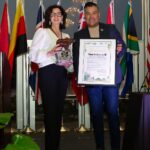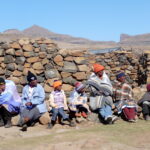Nigeria is turning to community-based flood forecasting to help manage the threat of severe flooding expected to hit 30 of its 36 states in 2025.
The country’s 2025 Annual Flood Outlook (AFO), released in Abuja by the Nigeria Hydrological Services Agency (NIHSA), highlights the urgent need for local preparedness as more than 1,200 communities are considered high-risk.
The forecast is themed Flood Resilience: Focusing on Communities Preparedness and Adaptation Strategies for Flood Management. It recommends early warning systems tailored to specific communities, rather than broad national alerts.
Worsening Flood Risks
In total, 2,187 communities across 293 local government areas in 31 states and the Federal Capital Territory (FCT) are expected to face moderate flood risk. Poor drainage systems and weak infrastructure are likely to worsen flash and urban flooding in major cities like Lagos.
“Flooding remains one of Nigeria’s most devastating natural disasters, and climate change is amplifying both its frequency and intensity,” said Joseph Utsev, Nigeria’s minister of water resources and sanitation, during the presentation of the Annual Flood Outlook (AFO).
Richard Pheelangwah, permanent secretary of the ministry, echoed the concern by drawing attention to the toll flooding takes on communities, infrastructure, and the environment.
Pheelangwah stressed the urgent need for robust prediction, preparedness, and response systems, especially in light of climate change and past devastating floods in 2012 and 2022.
Localised Forecasting
“To strengthen early warning and response systems, this year’s outlook adopts a community-based flood forecasting approach. Instead of broad, generalised predictions, the forecasts are now tailored to specific communities—enabling more targeted communication and enhancing preparedness at the grassroots level,” stated NIHSA in a Facebook post.
Flood risks have been mapped over three periods:
- April–June: 657 communities across 52 LGAs
- July–September: 544 communities in 142 LGAs
- October–November: 484 communities in 56 LGAs
“This year’s flood forecast goes beyond mapping LGAs and the focus has expanded to assess sectoral impacts, on health, education, agriculture, and infrastructure, offering more robust tools to policymakers and disaster risk managers,” claimed Umar Ibrahim Mohammed, director-general and chief executive officer of NIHSA.
Flood Insurance and Resilience
The Nigerian government has launched a National Flood Insurance Programme (NFIP), the first of its kind in the country. It aims to protect vulnerable households, farms, and livestock. The scheme will begin with pilot projects in flood-prone Kogi and Jigawa states.
Other government plans include:
- The Niger Flood Project to improve irrigation, flood control, inland navigation, and eco-tourism along the River Niger.
- The Integrated Climate Resilience Innovation Project (I-CRIP) to tackle food security, water management, and energy needs through collaboration with five ministries.
Utsev also announced plans to launch an annual drought outlook later this year to complement flood forecasts and promote integrated, long-term water resource planning.
The floods in 2025 are very likely to have severe impacts on human lives, property, agriculture, and infrastructure as seen in the past and demand better planning, to address the risks.
In 2024, at least 320 people died and 1.3 million were affected by floods in 31 Nigerian states.
According to the United Nations office for the coordination of humanitarian affairs, the Nigerian senate has called on the federal government to develop a comprehensive “Marshall Plan” to address the country’s recurring flooding issues, particularly as climate change is expected to increase rainfall and worsen floods.











